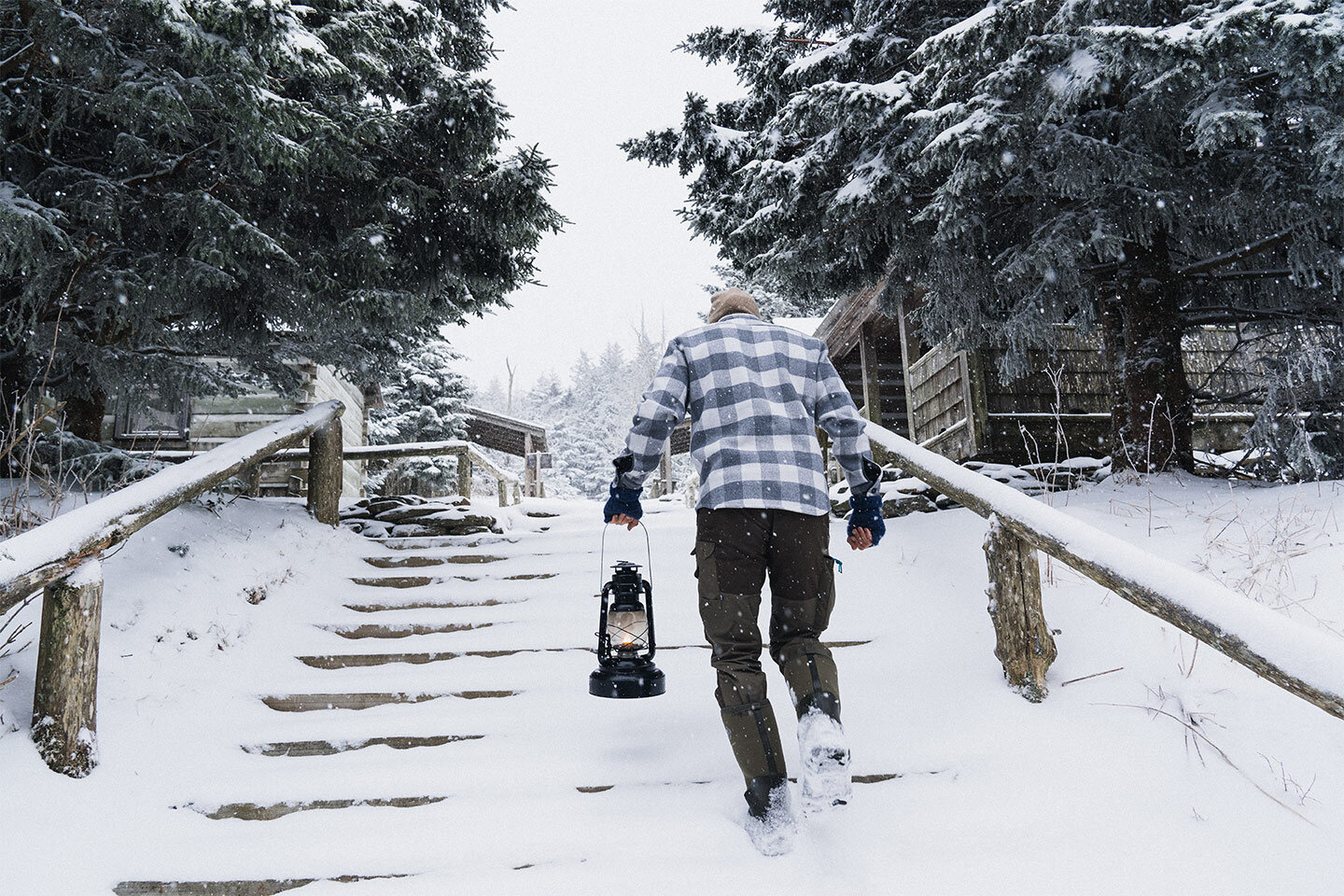The Caretaker
“The way I see it, one of the reasons we have this national park is because of this lodge.”
There is a cold wind blowing at 6,593 feet. The red spruce and balsam fir trees stir in the breeze as the clouds grow out to the west. My ice traction bites into the trail as I climb higher up the mountain, passing frozen springs and snow covered ground.
High atop Mount LeConte in the Great Smoky Mountains National Park stands LeConte Lodge, the highest guest lodge in the eastern United States. From March to November the lodge hosts thousands of guests within the backcountry of the national park. During the winter months only one man lives on the mountain, the caretaker.
The trail flattens out as I gain the ridgeline; the forest becoming distinctly coniferous at this elevation. A small log cabin comes into view amidst the frozen landscape. The roof appears speckled from this distance, its wooden shingles hold every color from gray to black. Past it I can see other buildings, mostly small cabins, huddled below the mountain. Seth sees me coming and meets me at the kitchen door with a smile, “Welcome to LeConte.” The kitchen interior is more capable than the shingled roof lets on. A commercial six burner propane stove sits along the wall over twin ovens. To its left are shelves full of spices and cookbooks organized neatly side by side. Water jugs line the back wall by the washing station and I notice a picture of the Beatles stuck to the freezer as I move past. A kerosene lantern hangs from the rafters over the small kitchen table and National Geographics lie scattered across it.
“Put some water on to boil and make coffee. I’m just finishing the daily blog,” Seth says, grabbing his computer. “Lots of people are curious with daily living in a national park in winter.”
For the past two winters, Seth Orme has been the caretaker atop Mount LeConte. He arrives near the end of November and comes down off the mountain middle of March - just over 100 days living in the woods. “Being a caretaker I have a responsibility to help not only keep a good eye on things and have that human presence here but also to share the beauty of this mountain in the winter,” Seth says.
Established in 1925, LeConte Lodge began as a simple tent camp used to host Washington dignitaries. From the numerous vistas on the mountain, the surveyors were able to experience the full rugged beauty of the surrounding mountains. A decade later Mount LeConte, and the surrounding region was protected as part of the Great Smoky Mountains National Park. The lodge expanded in the coming years from a single cabin to a series of small personal log cabins, a central lodge and dining hall. These days the lodge can accommodate 50 nightly guests and sees thousands of people pass by its doorsteps along the popular hiking trails that cover the mountain.
Due to the limited access of the lodge, every spring the crew will airlift approximately 35,000 lbs of supplies and fuel to the top of the mountain. The summer crew then spends a week or so organizing the supplies and preparing the cabins for the arriving guests. In order to have perishable foods throughout the season the lodge uses a team of llamas led by a crew member as a resupply train. Three days a week the llamas climb the mountain to deliver fresh eggs and bacon among other supplies.
There is no easy way to reach the mountain top, and the lodge itself grows out of the landscape, it’s timbered cabins blend cleanly into the side of the mountain. Guests and park visitors can only access LeConte by one of five backcountry trails that climb the mountain. There are no roads. The trails range in length from 5.5 miles to 10 miles. At 5.5 miles, Alum Trail, is the most popular trail as it is the shortest route up the mountain. However, as it climbs nearly 3,000 vertical feet it is one of the steeper options.
“Previously to being a caretaker I was essentially a vagabond,” Seth muses. It’s morning now, and we’re sitting in Seth’s cabin watching the snow fall quietly outside. Seth sits at his desk below the window, his park radio rests on the back of the desk. A moleskin lies open under his hand, yesterday’s thoughts put to paper. Two make-shift clotheslines adorned with a handful of shirts and socks stretch over the propane heater in the back corner. A pair of running shoes are propped up nearby to dry. There is a stack of books on the bed, a collection many caretakers before have added to. Over a hot bowl of chili the night before we listened to the radio as the rangers closed access to the national park road by road. This morning as the snow falls, no one is getting in or out unless on foot.
“I had a shift in values,” Seth admits, “a kind of a paradigm shift, where I put more value into experiences, things that I could share with my grandchildren, then I did with having an extra zero in my bank account. I got hit by a car going through a green light, yea, driving through a green light and boom, got hit by a truck. I woke up in the hospital, 18 years old and they were like, ‘you’re bleeding on the inside and we don’t know how bad.’ So that was kind of like a ‘hmm’ 18 years old and I could die tonight. Am I really living exactly the way I want to be living my life?”
“To often we think that investing only means money, but it also means experiences and perspective and health”
The experience changed his perspective on what it means to live a fulfilling life. After recovering, Seth decided to double down on the things he loved. At 19, he kayaked the Mississippi River from Lake Itasca down to the Gulf of Mexico. In 2015, he hiked the 2,200 mile Appalachian Trail from Georgia to Maine with two friends. Over the duration of the hike they packed out over 1,110 lbs of trash they found along the way. The following year Seth continued the tradition by hiking the 2,650 mile Pacific Crest Trail, managing to carry out over 720 lbs of trash found along the trail’s corridor. In 2017, he turned his ambition to biking, traveling 5,000 miles across the country on two wheels.
“I was always on the move, always planning the next project then gone for five months,” Seth says. “Living up here last winter was the longest I’d been in one place in the last five years.”
“And that’s what I realize looking back on it all, it’s not about possessions or anything, it’s about time.” The snow has picked up outside. “Time is that nonrenewable resource that we’re never getting back, it won’t ever come back. So what are we putting our time into? Some people don’t want to go live in the woods. Or paddle down rivers. Or not shower for 20 days. Some people have those thoughts but are afraid to chase them because of what people may think.” He pauses, looking down at his hands. “To often we think that investing only means money, but it also means experiences and perspective and health.”
The snow is still falling as the kettle comes to a boil. There was five inches of powder last time we checked. I pour the water into the french press and close the lid. Through the window I see Seth standing outside on the porch watching the morning. There is a soft light filling the kitchen as yesterday’s cornbread still sits in the cast iron on the stove. I pour my coffee and join Seth outside.
"For a while I thought traveling, that's how you get this, you have to keep rolling, keep seeing the beautiful stuff. Go out and see as much as you can, meet as many people as you can, sample the world. I still think that’s important for perspective and worldview but being okay with the same every day and finding beauty in that is - as I get older I think that’s the key to happiness.” His breath evaporates in the cold air. "Maybe that’s an offering Mount LeConte gives beside say food and lodging, it gives people an opportunity to let their imagination take over again.”
The life of a caretaker may look lonely and estranged to some but Seth would argue otherwise. Months alone atop a mountain seem to dare the wild to break a man. Winter is a barren season within the Great Smoky Mountains. The earth lies dormant under ice and snow and the lower elevation forests stand naked against the coldest months. For Seth, winter is the time to recalibrate, to realign his direction and goals for the coming year. It’s a time to heal injuries and to work on deficiencies, a season for preparation and planning so that when spring breaks he can run to meet it.
The caretaker leans in, his eyes fixed on the mountain. “We spend our whole lives trying to be kids again, right, this mountain allows us to get at least a step closer to that.”
Written and photographed for Buffalo Jackson with the support of LeConte Lodge










